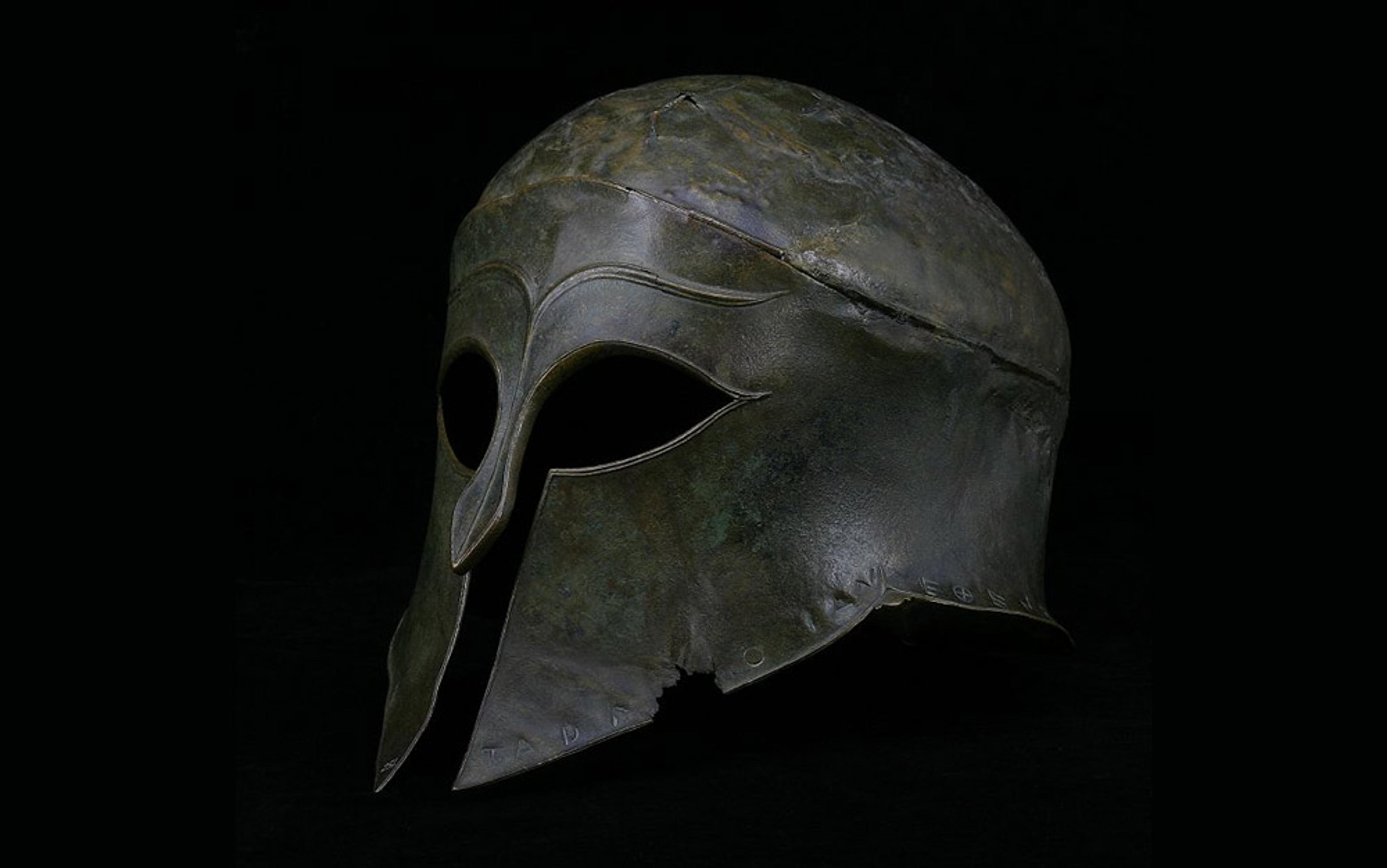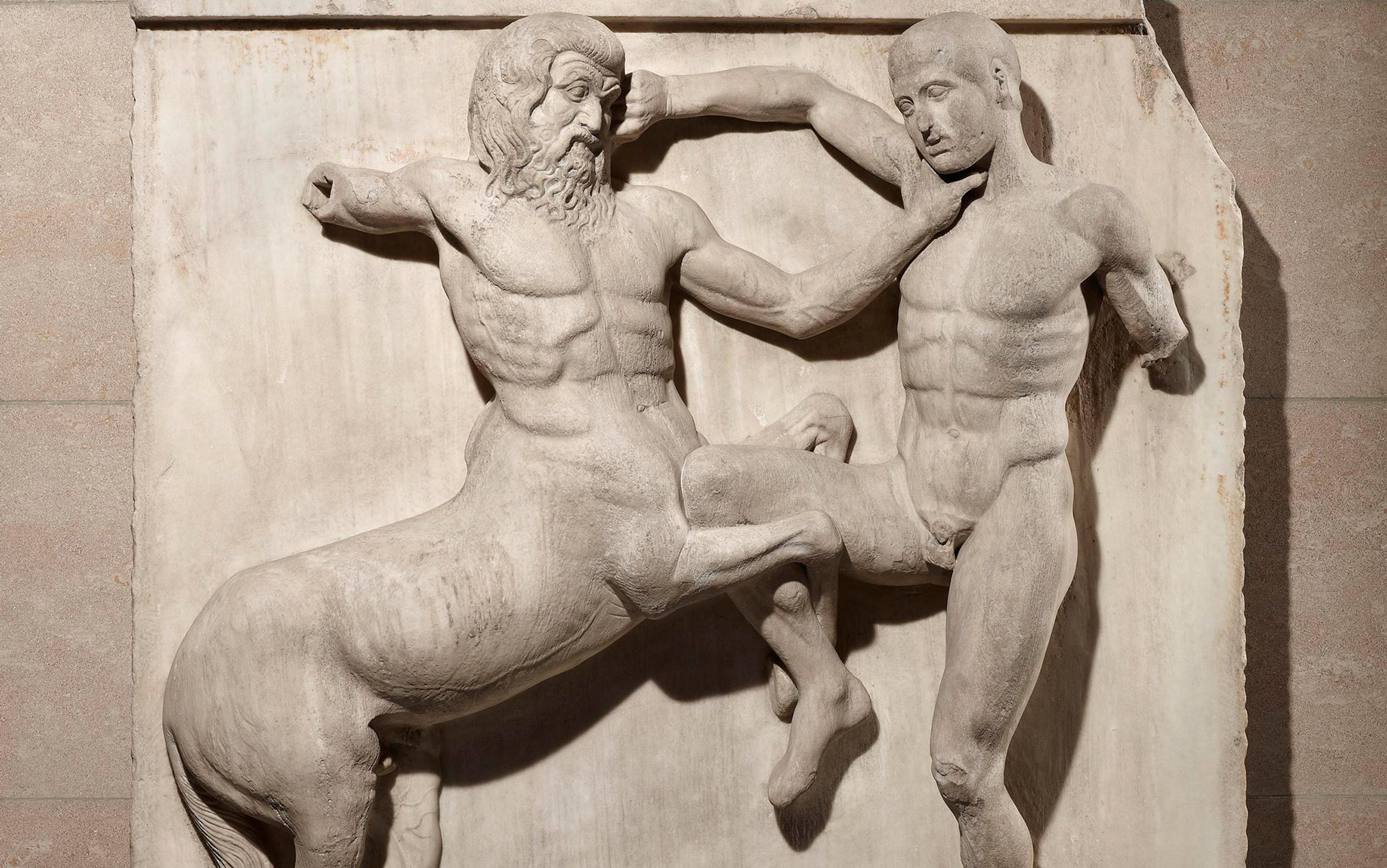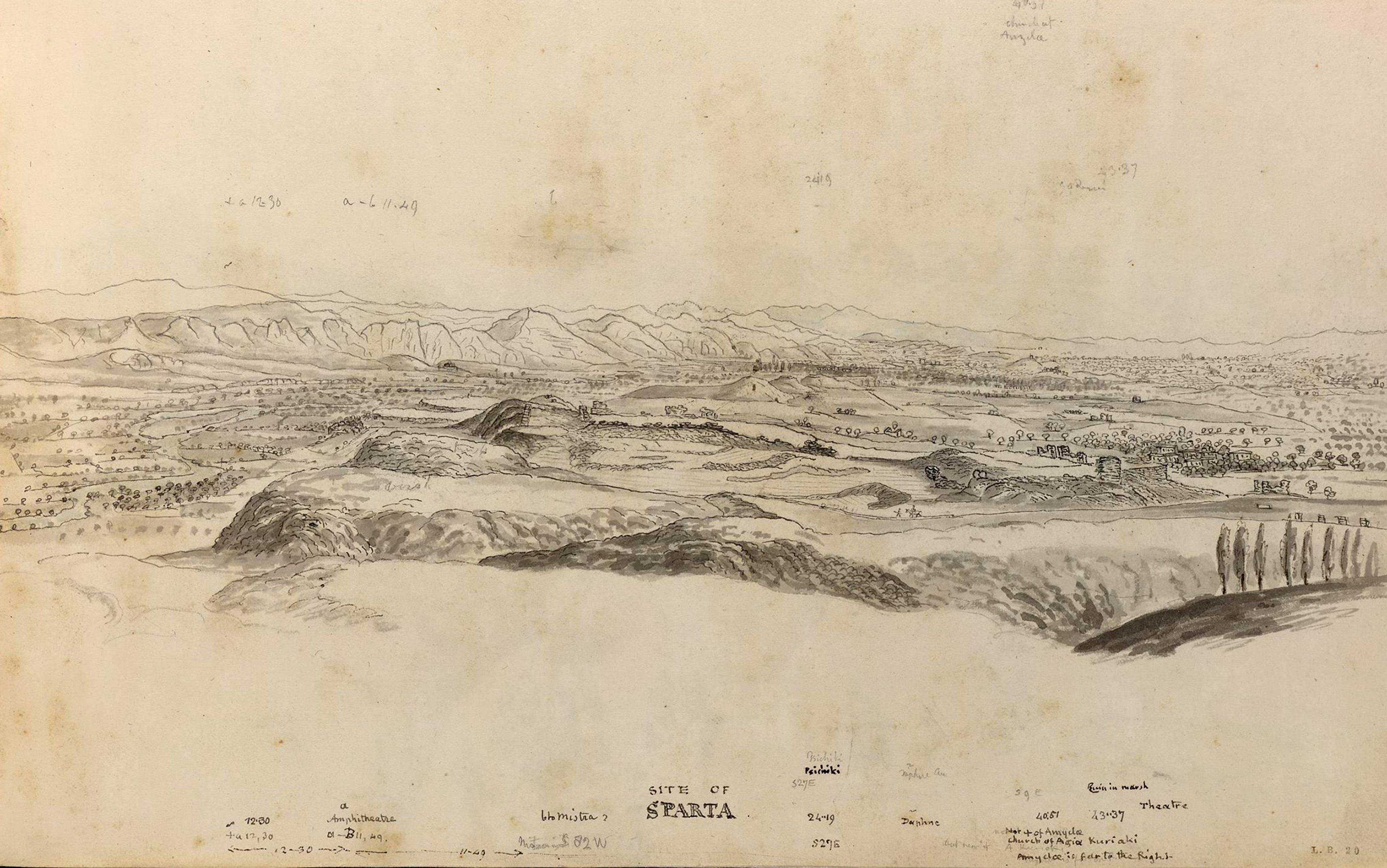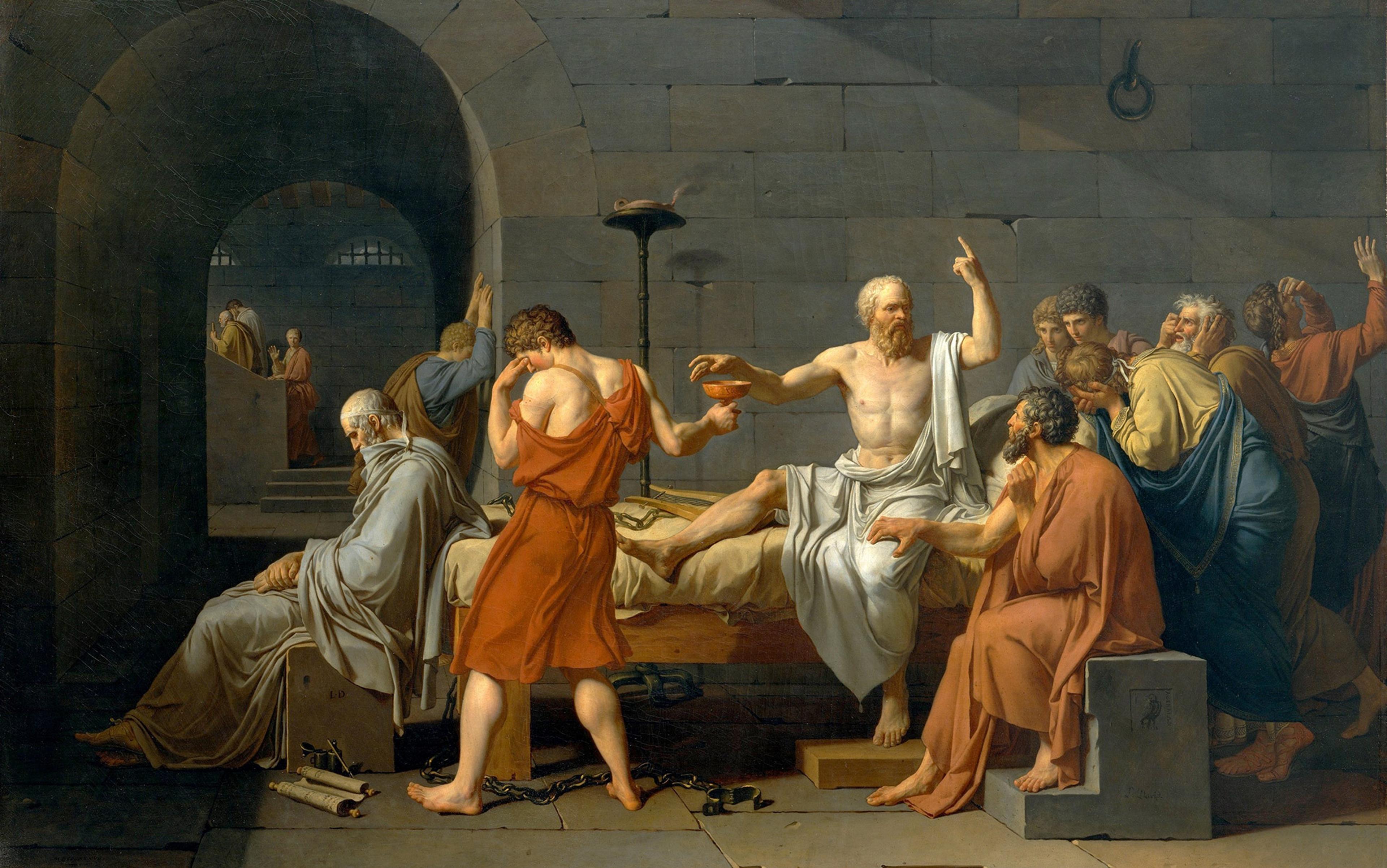The fall of Mycenaean power, the intervening Dark Ages, and the dawn of a new civilisation during the ‘Greek miracle’ of the Archaic period is one of the most fascinating stories in ancient history. After the collapse of the Mycenaean palace system around 1100 BCE, Greece experienced centuries of social and economic devastation. Pylos, Mycenae and Thebes were abandoned and burned to the ground. A dwindling population was attacked by invaders from the north and from the sea. What remained of Bronze Age culture was according to one historian ‘very little’, and ‘that little then dwindled away to almost nothing’. Writing at the end of the period, the 8th-century poet Hesiod described the degeneration of the human race, from glittering Bronze Age heroes, down to his own violent ‘Age of Iron’. He looked into the near future and saw children born grey, families at war with themselves, and society self-destructing. He concluded miserably: ‘I wish that I … had either died sooner or been born later.’
But it was at this moment that a new vision of society began to emerge. As the classical scholar Gilbert Murray put it in 1907 : ‘There is a far-off island of knowledge, or apparent knowledge; then darkness; then the beginnings of continuous history.’ The archaic period (800-480 BCE) represents the start of this history, when ‘darkness gives way to dawn’, according to the archaeologist J N Coldstream. And at its heart is the birthplace of the Western intellectual and political tradition: the polis or Greek city-state.
A polis was a self-governing city or town and its surrounding territory. In terms of size, it wasn’t necessarily big: Aristotle said that all the citizens of a polis (i.e, men) should be able to be assembled by the voice of a single herald. Plato gave an ideal citizenry of 5,040. Some poleis were smaller, but few were much larger. A typical city-state such as Plataea in Boeotia had a total population of fewer than 10,000. But from its modest beginnings, the idea of the polis soon spread. At the highpoint of Greek civilisation (c400 BCE), around 1,000 had migrated across the shores of the Mediterranean – as Plato put it: ‘like frogs around a pond’.
Given these geographic variations, many chose to define the polis anthropologically. ‘Not well-built walls, nor canals and dockyards make the polis: but men do,’ said Alcaeus of Lesbos. In Thucydides, the Athenian general Nikias states that: ‘It is men that make the polis, not walls or ships.’ Aristotle defined man as politikon zoon, a political animal: he ‘whose nature is to live in a polis’. At its heart was a conception of government for the people, by the people: of normative rules and collective decision-making. For the writers and philosophers of 5th-century Athens, this culminated in an ability to step back, not only from politics but from life itself, and subject it to something like objective scrutiny.
But the reasons for the success of the Greek city-state still remain unclear. Did it result from an expanding population or the group-think of the armoured hoplite phalanx? Were improvements in trade crucial, or was it the rise of sophisticated urban elites? Was it maintained by abstract ideals of democracy (demokratia), freedom (eleutheria) and free speech (parrhesia)? Or was the rise of the polis somehow the astonishing aftereffect of the simple act of drawing a line?
Literature can provide a useful source for understanding the polis. Homer composed around 750-700 BCE, at the same time as the polis was emerging. In the Odyssey, he describes the island of the ‘insolent and lawless’ Cyclopes – wild men living outside the polis and political life:
Neither assemblies for council have they, nor appointed laws, but they dwell on the peaks of mountains in hollow caves, and each one is lawgiver to his children and his wives, and they have no regard for one another.
They live individualistically; their laws govern only their own families. With their limited vision, they have little sense of a public sphere. But what makes the Cyclopes so lawless and monstrous, according to Homer, is not simply their lack of an eye, but their lack of an assembly or agora.
The agora was at the heart of the polis. It was an open square situated towards the centre of the city, and for many historians provides the hallmark of the Greek city-state: as the classicist Paul Cartledge at the University of Cambridge says, it was ‘one of the most basic distinguishing markers of ancient Greek culture and civilisation’. In later years, the agora gained market stalls and temples, council buildings and law courts, becoming, in the words of the historian John Ma at Columbia University, ‘the public space par excellence, owned and controlled by the community’.
What is important about the agora is that it is not simply a space, but a defined space, a bounded absence
At the heart of these conceptions is the idea of the agora as a place of ‘bringing together’, a ‘meeting place’. The archaeologist Malcolm Bell III at the University of Virginia calls it ‘a multivalent gathering place, not just a political centre’. The classicist John Camp at Randolph-Macon College in Virginia describes it as the city-state’s ‘heart and soul’. And into this empty space historians and political theorists have poured their own egalitarian ideals. It was a ‘democratic space’, a ‘communal space’, a ‘melting pot’.
Such depictions are uncontroversial, and capture much of the flavour of the agora in the later classical era (480-323 BCE) where public and private, politics and profit mingled. But whether they explain the beginnings of the agora in the first place seems less clear. For one might ask: why might a young community feel the need to create a space in which to meet? Certainly people need a place to meet – around a water hole, on a street corner; many African villages conduct their meetings under the shade of a tree. But that people need a space for meeting seems less obvious – and wasn’t there plenty of space around anyway? For what is important about the agora is that it is not simply a space, but rather a defined space, a bounded absence. An upright stone marking the edge of the agora from Epidaurus on the Peloponnese is inscribed: ‘boundary of the agora’. But what might this boundary mean?
In book 18 of the Iliad, Homer breaks off from the battle between the Greeks and the Trojans and seeks out a moment of calm before the impending storm: Achilles’ brutal revenge for the death of Patroclus, his slaughter of Hector and dishonouring of his body, and the mass killing of Trojans that will leave the river Skamandros brimming with blood.
Instead, Homer conducts us into the workshop of Hephaestus, the blacksmith to the Gods. There, Thetis petitions him to make a new suit of armour for her son Achilles. Hephaestus sets to work, building a shield five layers thick, decorating it with the sun and the sea and the moon and the stars, its boundary formed by the ocean. He depicts a city, ‘busy with the hum of men’, and a wedding party with flutes and lyres and dancers.
But then Homer’s vision darkens:
Men had gathered in the market-place where a quarrel was in progress, two men quarrelling over the blood-money for a man who had been killed: one claimed that he was making full compensation, and was showing it to the people, but the other refused to accept any payment: both were eager to take a decision from the arbiter. The people were taking sides, and shouting their support for either man, while the heralds tried to keep them in check. And the elders sat on the polished stone seats in the sacred circle, taking the rod in their hands as they received it from the loud-voiced heralds.
The shield of Achilles has sometimes been interpreted as a portrait of the good life, a reminder of all that the Greeks are fighting for. But this seems to be undermined by the image at its centre: of violence, vengeance and murder. Moreover, it looks like things could kick off at any moment – the crowd is shouting and taking sides, with the heralds struggling to hold them back. In contrast to our tendency to idealise the agora, Homer reminds us of a simple but important fact: the agora was not only a place for bringing people together, but also for keeping them apart.
In the essay ‘Deep Play: Notes on the Balinese Cockfight’ (1972), the American anthropologist Clifford Geertz reveals cockfighting to be more than a crude blood sport, but a manifestation of many of the deepest concerns of Balinese life. ‘As much as America surfaces in a ballpark, on a golf links, at a race track, or around a poker table, much of Bali surfaces in a cock ring. For it is only apparently cocks that are fighting there. Actually, it is men.’
Balinese men are inordinately fond of their cocks, and Geertz reminds us that the double entendre works ‘exactly the same way in Balinese as it does in English’. They preen and plump and arm their charges, rubbing pepper into their beaks and sharpening their spurs. They bet aggressively against the cocks of competing kinship groups, and stolidly back their own.
The cocks fight in a circle about 15m square. In pre-colonial times, Geertz notes, the ring, or wantilan, was situated at the heart of the community, beside the council building, the marketplace and the temple. But while now relegated to the corner of the village, the link between the collective life and bloodsport ‘remains intimate and intact’.
The cockfight helps to address the problem facing any growing egalitarian community: how to manage violence
For Geertz, cockfighting functions as ‘a simulation of the social matrix’ where prestige is vicariously contested, defended, lost and regained. It fulfils the function of great art, taking ‘death, masculinity, rage, pride … [and] presents them in such a way as to throw into relief a particular view of their essential nature’. It celebrates and sublimates violence. The owners seek out opponents in a quiet, almost ‘dissembling’ manner. In ‘near silence’, the crowd watches the ‘animal fury’ in the ring. And in everyday life, Geertz notes, Balinese men ‘are shy … of open conflict. Oblique, cautious, subdued, controlled.’
The cockfight thus helps to address the overwhelming problem facing any growing egalitarian community: how to manage violence. As population increases, sub-groups develop and faction ensues, what anthropologists call ‘scalar stress’. Research has shown that communities tend to ‘fissure’ when they reach figures in the late 100s. The Hutterite Anabaptist communities in the 19th-century US split at around 150; among the Yanomami, of South America, conflict arises nearer 200. Moreover, the evolutionary psychologist Robin Dunbar at the University of Oxford argues that such limitations are hard-wired. Scaling up from the size of primate brains, and primate groups sizes, he estimates that we can maintain meaningful relationships only with around 150 people – the average size of a village in the Doomsday book – with an upper limit of around 230. Tihingan, the village in which Geertz carried out his field work, had a population of 720.
Death, masculinity, rage, pride – these were sentiments familiar to the Greeks. The Iliad begins: ‘Rage – Goddess, sing the rage of Peleus’ son Achilles.’ Despite its later incarnations, the original function of the agora might therefore have been less of a meeting place, and more of a fighting place – an arena in which to stage, examine, resolve or postpone violence. In his Works and Days, Hesiod chastises his brother Perses for wasting his time ‘gawking at brawls’ in the agora. As Achilles squares up to Agamemnon in the agora at the beginning of the Iliad, he is stopped from killing him only by the goddess Athena grabbing his hair. Homer tells of Thoas, a man famed for ‘close fighting’ but who is equally combative in the agora, ‘whenever the young men competed in debate’.
For the Greeks, speaking and fighting were not necessarily opposed activities: defeating an opponent was not enough, you had to humiliate him, and they taunted and goaded him to that effect. In The World of Odysseus (1954), Moses Finley concludes that when an assembly (agora) is convened in the Iliad, it never results in ‘rational discussion’ but rather ‘quarrels’ won ‘by harangue and by warning’. In 4th-century Athens, a long-running feud exploded into violence when Conon set about Ariston in the agora, splitting his lip, beating him to the ground, and completing his humiliation by ‘crowing like a victorious fighting cock … flapping his arms like wings’.
And here the meaning of agora should be borne in mind. While often simplistically translated as ‘marketplace’, it can be linked to the word agon, meaning ‘contest’, or ‘combat’. (In Homer, agon can mean both combat and place of combat.) It is from agon that we get words such as antagonise, antagonist, protagonist, agony. Historians have argued that the early agora probably served as the location of sporting agones such as pankration, the early Greek form of wrestling, in which biting, kicking and breaking bones was allowed. When Homer’s Odysseus arrives at the agora in Phaeacia, he is quickly challenged by the young men to try his hand at a bout.
The agora served to not only discharge violence, but to quarantine it, shielding spectators from its contagious power
For a community experiencing ‘scalar stress’, the agora might have therefore offered something like a controlled explosion. It is this, rather than simply conviviality, that necessitates the laying out of a space. And key here were perhaps what Geertz calls ‘deep fights’ – fights between rival ‘big men’ where the stakes were high, and the result impacted the whole community. The agora ensured such violence was witnessed, recognising what anthropologists call the ‘triangle of violence’: of aggressor, victim and observer. An aggressor might seek an audience as a form of vindication; a victim in self-defence. But in witnessing violence, a community was also potentially judging the outcome, deciding on it, voting on it – the beginnings of something like a democratic process. One therefore wonders if the remains of older, smaller agoras – such as the 8th-century BCE, 23m x 40m agora at Dreros in Crete, with its seven rows of seats cut into the hillside – might have served such a purpose: too small for a marketplace, but big enough to stage a fight. One historian likens its layout to a ‘primitive theatre’.
But as with Geertz’s cockfight, it is what is happening outside the ring as inside it that’s important. As countless cowboy films celebrate, a single punch can soon turn into a bar-room brawl. In staging conflict, the agora served to not only discharge violence, but to quarantine it, and shield the spectators from its contagious power. Perhaps the greatest invention of Greek civilisation was not democracy, or philosophy, or the polis – although it might have ultimately led to such things – but simply a line.
A football referee attempting to keep a defensive wall back 10 yards before a free kick has various tools at his disposal. He can shout and blow his whistle. He can appeal to the players’ sense of gentlemanly conduct and fair play. But as many referees discovered during the 2014 World Cup, none are quite so effective as spraying a line on the grass with a can of foam.
Some time during the waning of the Greek Dark Ages, potters began to be obsessed by lines. Perhaps they saw the dawning of civility reflected in the interplay of dark and light, or the beginnings of philosophical thought in increasingly abstract designs. The revival of writing and the adoption of the Phoenician script probably played a role. But slowly the serpentine curves and arcs of earlier designs gave way to geometric art: perfect circles, zig-zags and meanders – the classic square wave that has come to represent ‘Greek’ to us all.
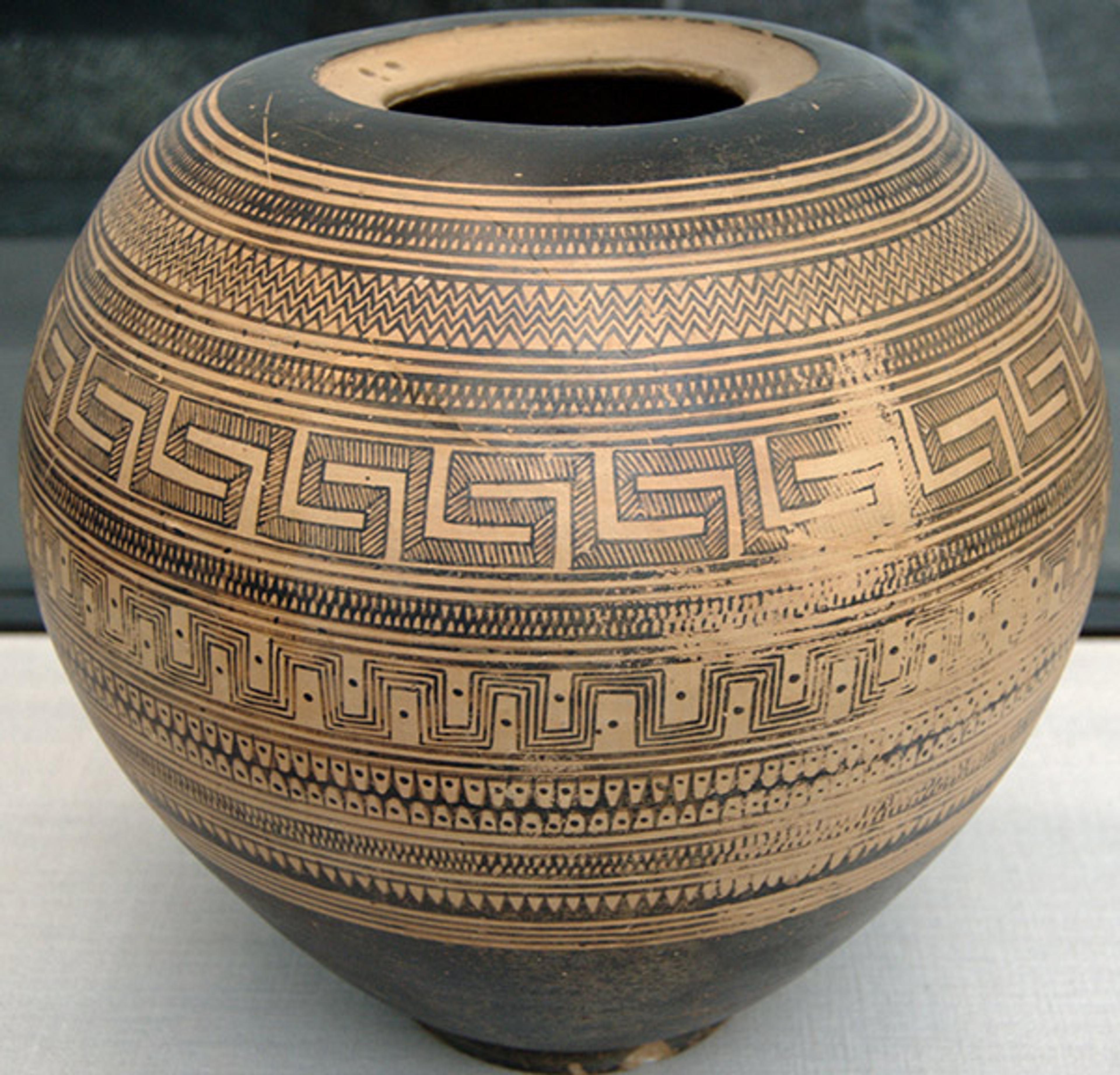
Attic Middle Geometric Pot c850 BCE/Staatliche Antikensammlungen, Munich. Courtesy Wikipedia.de
But this was only one dimension of a growing preoccupation with form – seen in the planned colonial poleis spreading across the Mediterranean, and a mathematical fascination with triangles, circles and squares. In Aristophanes’ The Birds, the geometer Meton maps out a city in the sky, complete with an agora, using ‘air rulers’ of protractors, compasses and straight edges.
The Greeks were also a practical people, and at some point during this period they drew a line between combatants and spectators, separating violence and audience, creating the stone circle at the centre of the shield of Achilles. A statue base from Athens (c510 BCE) almost shows this process in action, as two men are depicted beside a wrestling bout: one attempting to push the wrestlers back into the centre, another using a long stick to draw the ring.
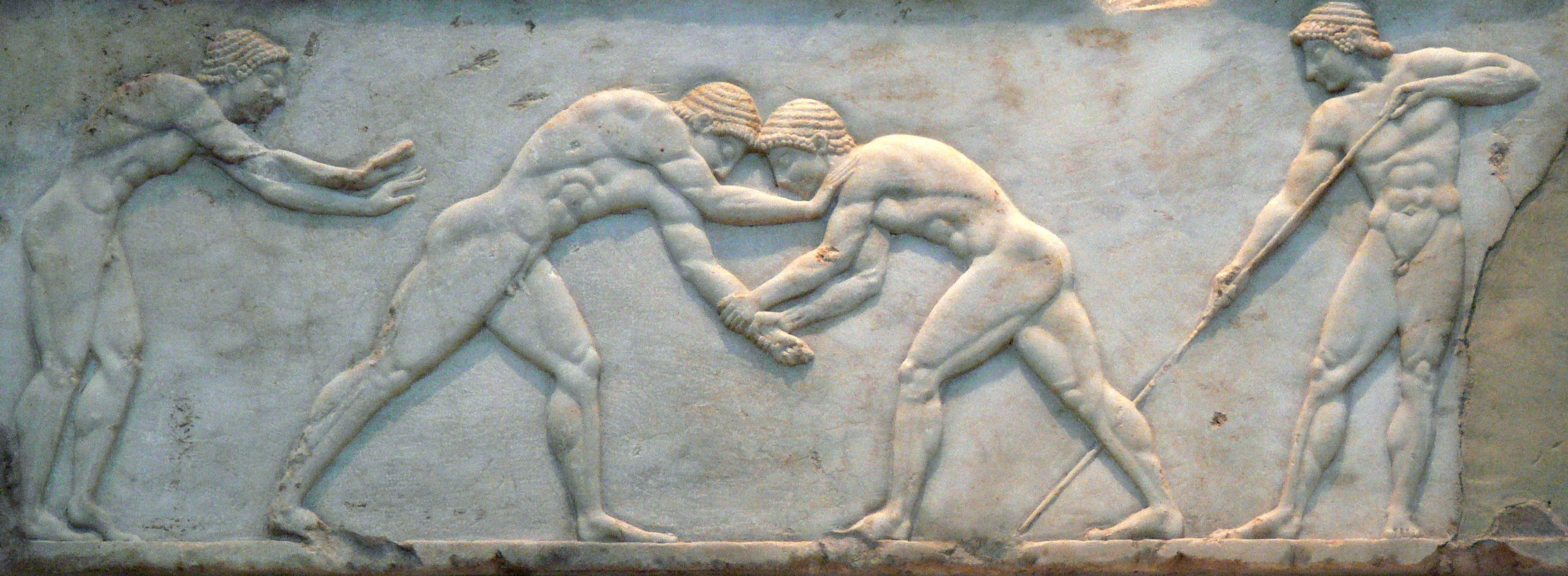
Statue base, Dipylon Cemetery, Athens, c510 BCE, National Archaeological Museum, Athens, Greece. Courtesy Wikipedia
And this geometric instinct is perhaps seen in the blacksmith Hephaestus himself. Homer uses the verb etithei – to fix in place – as he distributes the elements around the shield with its concentric metal bands. Such fixity Homer found appealing. In the Odyssey, he describes admiringly the agora of the Phaeacians, with its boundary stones ‘bedded deeply in the ground’. It is on one of these that Odysseus sits as spectator to the games that are put on in his honour, and resists the taunts of the local youths (instead of wrestling, he shows off by throwing a discus).
Homer moulds and circumscribes human existence in order that it can be witnessed – life itself as an agora
For the Greeks, placing a boundary around the agora conferred a number of advantages. It stretched out the space between combatants, allowing violence to be more easily regulated. It separated fighters from their kinsmen, and rival kinsmen from each other, helping to stop the fight spreading to the community at large. When Aias and Idomeneus begin to quarrel during the chariot race at the end of the Iliad, Achilles instructs them to shut up and rejoin the spectators.
In standing outside rather than inside the circle, the spectators might also have experienced something like a democratic mentality. Now they had a voice, a numerical power, over the violent ‘big men’ slugging it out in the ring. During the funeral games for Patroclus in book 23 of the Iliad, the lethal fight between Aias and Diomedes is halted when the Achaians ‘terrified for Aias, shouted for them to stop and share the prize equally’. Dreros, the site of the early theatre-like agora, is also home to the first recorded law (c650 BCE). It states that the polis (the first time this word is used) decrees that no man may be kosmos (magistrate) more than once in 10 years – suggesting ‘the many’ beginning to curb the tyrannical ambitions of a powerful ‘few’.
But in creating an audience, the line around the agora also made spectating an essential part of the Greek mind. In the 5th century BCE, Cleon described the Athenians as ‘spectators of speeches’. Plato coined the word theatrokratia, ‘theatrocracy’ – of politics as spectator sport. The American philosopher John Dewey described Greek philosophy as offering a ‘spectator theory of knowledge’, in which one always stands as an ‘outside spectator’ to what is known. This spectating impulse is reflected in the birth of Greek theatre, whose early home was almost certainly the agora. It made agonistic argument – debate – central to political and philosophical life. And it informs Homer himself, who, like Hephaestus, moulds and circumscribes human existence in order that it can be witnessed – of life itself as an agora. But, most importantly, it gave birth to the idea that through a democratic process men could momentarily step outside the polis, observe it, and judge it, without stepping back across the boundary into violence itself. The ‘Greek miracle’ of the agora thus constituted a revolutionary suspension of belief: the belief that politics was necessarily held hostage to that Homeric obsession – rage.

